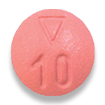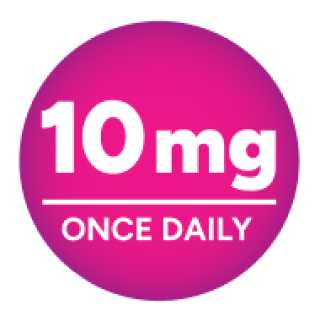REFERENCES: 1. XARELTO® [prescribing information]. Titusville, NJ: Janssen Pharmaceuticals, Inc. 2. Cohen AT, Spiro TE, Büller HR, et al; MAGELLAN Investigators. Rivaroxaban for thromboprophylaxis in acutely ill medical patients. N Engl J Med. 2013;368(6):513-523. 3. Supplement to: Cohen AT, Spiro TE, Büller HR, et al; MAGELLAN Investigators. Rivaroxaban for thromboprophylaxis in acutely ill medical patients. N Engl J Med. 2013;368:1-14. Accessed April 29, 2024. https://www.nejm.org/doi/suppl/10.1056/NEJMoa1111096/
In the MAGELLAN subgroup*
Reduced risk of VTE: Efficacy results at day 10 and day 35 in
acutely ill medical patients† vs standard of care2,3
Day 10‡§
18% RRR||
0.6% ARR¶
Noninferior reduction in VTE-related events vs enoxaparin
(per protocol population)
Day 35‡§
32% RRR||
1.8% ARR¶
Reduction in VTE-related events vs enoxaparin/placebo
(mITT population)
The primary day 10 analysis was prespecified to be a noninferiority analysis, and the primary day 35 analysis was prespecified to be a superiority analysis.
Compared to enoxaparin/placebo, XARELTO® demonstrated a noninferior VTE rate at 10 days and a lower VTE rate at 35 days
- Day 10: 2.4% (58/2385) of patients taking XARELTO® experienced a VTE event versus 3.0% (72/2433) of patients taking enoxaparin
- Day 35: 3.9% (94/2419) of patients taking XARELTO® experienced a VTE event versus 5.7% (143/2506) of patients taking enoxaparin/placebo
*The MAGELLAN subgroup excluded ~20% of patients with any of the following 5 conditions that led to a higher risk of major bleeding: active cancer (ie, undergoing acute, in-hospital cancer treatment), receiving DAPT, active gastroduodenal ulcer within the 3 months prior to treatment, history of bronchiectasis, pulmonary cavitation, or pulmonary hemorrhage, or history of bleeding within the last 3 months. Major bleeding was defined as overt
bleeding associated with a drop in hemoglobin of ≥2 units g/dL, a transfusion of ≥2 units of packed red blood cells or whole blood, or bleeding at a critical site or with a fatal outcome.
†Patients excluded due to high risk of bleeding: history of bronchiectasis, pulmonary cavitation, or pulmonary hemorrhage; active cancer (ie, undergoing acute, in-hospital cancer treatment); active gastroduodenal ulcer in the 3 months prior to treatment; history of bleeding within the last 3 months prior to treatment; or receiving DAPT.
‡Primary efficacy outcomes: the composite of asymptomatic proximal DVT, symptomatic proximal or distal DVT, symptomatic nonfatal PE, or VTE-related death.
§Patients received either XARELTO® or placebo once daily for 35 days ±4 days starting in hospital and continuing post hospital discharge, or received enoxaparin or placebo once daily for 10 days ±4 days in the hospital.
||RRR calculated using 1 minus HR.
¶ARR = risk (placebo) - risk (experimental).
ARR = absolute risk reduction; BMI = body mass index; DAPT = dual antiplatelet therapy; DVT = deep vein thrombosis; PE = pulmonary embolism; RR = relative risk; RRR = relative risk reduction; VTE = venous thromboembolism.
In the MAGELLAN subgroup
Rates of bleeding among acutely ill medical patients at
day 352,4*†
| Clinical endpoint | XARELTO® 10 mg %/year | (n/N) | Enoxaparin 40 mg (inpatient)/ placebo (outpatient) %/year | (n/N) |
|---|---|---|
| Major bleedingठ| 0.7 (22/3218) | 0.5 (15/3229) |
| Fatal bleeding|| | <0.1 (3/3218) | <0.1 (1/3229) |
Critical site bleeding¶ | 0.2 (9/3218) | 0.1 (4/3229) |
| CRNMB# | 2.9 (93/3218) | 1.1 (34/3229) |
~99% of patients taking XARELTO®
did not experience a major bleeding event
~97% of patients taking XARELTO®
did not experience a clinically relevant nonmajor bleeding event; however, these events were increased with XARELTO® vs SOC
*Patients excluded due to high risk of bleeding: history of bronchiectasis, pulmonary cavitation, or pulmonary hemorrhage; active cancer (ie, undergoing acute, in-hospital cancer treatment); active gastroduodenal ulcer in the 3 months prior to treatment; history of bleeding within the last 3 months prior to treatment; or receiving DAPT.
†Patients received either XARELTO® or placebo once daily for 35 days ±4 days starting in hospital and continuing post hospital discharge, or received enoxaparin or placebo once daily for 10 days ±4 days in the hospital.
‡Major bleeding events occurred during treatment or within 2 days of stopping treatment.
§Defined as bleeding associated with a drop in hemoglobin of ≥2 g/dL, a transfusion of ≥2 units of packed red blood cells or whole blood, bleeding at a critical site, or with a fatal outcome.
||Fatal bleeding is adjudicated death with the primary cause of death from bleeding.
¶Critical site bleeding was defined as bleeding into a critical site such as intracranial, intraspinal, intraocular, retroperitoneal, intra-articular, pericardial, or intramuscular with compartment syndrome.3
#Clinically relevant bleeding was the primary safety endpoint of the MAGELLAN study and was a composite of major bleeding and clinically relevant nonmajor bleeding. Clinically relevant nonmajor bleeding was defined as overt bleeding not meeting the criteria for major bleeding but associated with medical intervention, unscheduled contact with a physician, temporary cessation of study treatment or discomfort for the patient such as pain, or impairment of activities of daily life.
CRNMB = clinically relevant nonmajor bleeding; DAPT = dual antiplatelet therapy; SOC = standard of care.
Dosing
Acutely ill medical
patients*†

10 mg
10 mg once daily
In hospital and after hospital discharge, for a total recommended duration of 31 to 39 days, with or without food, in patients with CrCl ≥15 mL/min
Avoid use in patients with CrCl <15 mL/min
Tablets not shown actual size.
*For VTE prophylaxis in acutely ill medical patients at risk for thromboembolic complications who are not at high risk of bleeding.
†Patients with CrCl <30 mL/min were not studied, but administration of XARELTO® is expected to result in serum concentrations of rivaroxaban similar to those in patients with moderate renal impairment (CrCl 30 mL/min to
<50 mL/min).
CrCl = creatinine clearance; VTE = venous thromboembolism.

